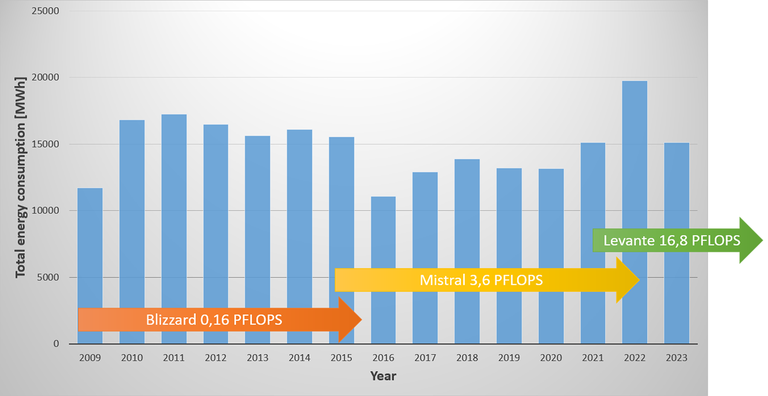Energy Consumption
The total energy consumption of the DKRZ's systems depends on the system load and, to a much greater extent, on the number of HPC systems running. During the installation of a new system and the subsequent overlap phase, two HPC systems are operated in parallel, as was the case in 2021/2022, for example.
CO2 Emissions
For all the electrical energy consumed at DKRZ, there are certificates of origin from plants that generate renewable energy (in our case, mainly hydroelectric plants in Norway), so that no CO2 is released into the atmosphere as a result of the operation of the computers. However, one must honestly admit that this interpretation is not without controversy.
The following table shows the development of total energy consumption and the corresponding CO2 emissions for the years 2014-2022, assuming that the emissions would not have been offset by certificates.
* CO2 emissions based on the energy mix as reported by the supplier
The actual CO2 emissions associated with a certain amount of energy depend on the energy mix produced and sold by energy providers. Depending on the market situation and the energy supplier, the electricity comes from different sources. The following table shows the energy mix provided by our energy suppliers** for the period from 2017 to 2023.
** values based on the energy mix as reported by the supplier; values for German mix (in parenthesis) by www.umweltbundesamt.de
>*** no current value reported, so the previous year's value is used
- 2017-2019: Energie Vertrieb Deutschland EVD GmbH
- 2020-2021: SWM Versorgungs GmbH
- 2022 - : enercity AG
- 2024 - ongoing: DREWAG - Stadtwerke Dresden GmbH
Distribution of the energy requirements within the data center
DKRZ's total energy consumption is naturally dominated by its supercomputer. A rough breakdown of the individual shares of the entire data centre for 2022 is as follows:
- Supercomputer and parallel file system: 75 %
- Infrastructure: 10%
- Additional smaller systems: 15 % (like object store and tape library)
Energy efficiency of the data center
The PUE (Power Usage Effectiveness) value of a data center indicates how efficiently electrical energy is used. The PUE is determined as the quotient of the total power consumption of the data center (including power for cooling, uninterruptible power supply and other infrastructure required to operate the computers) divided by the energy demand of the computers. The lower the PUE value, the more efficient the cooling and other technical infrastructure of the data center.
To determine the PUE value, a data center or a new computer must have run through at least one full annual cycle, since the energy required for cooling depends on the outside temperatures. For this reason, only an estimated value can currently be given for Levante; the PUE value (annual average) is likely to be less than 1.1.
Enhancing energy efficiency
High-temperature liquid cooling
The Levante supercomputer is cooled on the basis of high-temperature liquid cooling. This is a particularly energy-efficient technology, as the system can be operated all year round without the need for additional electrical cooling.
Increasing energy efficiency through waste heat recovery
About 3 GWh/year of the heat generated by the supercomputer is effectively used to heat laboratories in a neighboring building at the University of Hamburg, thus reducing the energy footprint of the data center. Read more ...
Research projects aiming at an increase in the energy efficiency of simulation codes
DKRZ is currently involved in two research projects that aim to pave the ground for further inceases in the energy efficiency in the area of supercomputing. Read more ...

